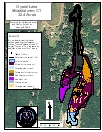Crystal Lake, Middletown - 2004
2004 Aquatic Plant Survey Map of Crystal Lake
Crystal Lake has a dam at its northern end, and the city of Middletown owns a beach and park at the southern end. Only Middletown residents are allowed to use the park and beach. A state boat ramp is located on the southeast shore, but motors are banned from the lake. The western side of the lake is heavily developed with residential property, all connected to public sewers. The eastern side of the lake is much less developed, and all the homes have private septic systems.
Seven aquatic plant species were recorded in Crystal Lake during a survey on Aug. 6, 2004. Two of these were invasive species – Eurasian watermilfoil (Myriophyllum spicatum) and curlyleaf pondweed (Potamogeton crispus). Eurasian watermilfoil appeared to be the most abundant plant in the 32.4-acre lake, occurring everywhere except in water more than 12 feet deep. The species was particularly abundant in water less than 6 feet deep.
Curlyleaf pondweed was found in patches in the southeast part of the lake, including one large patch on the eastern shore, as well as in the northern end of the lake and in several patches in the lake’s southwestern bay. The species was not particularly abundant; however, because it had largely died back by the time of the survey. Several newly sprouted turions (vegetative propagules produced at the end of the growing season) were collected during the survey, indicating that the species had begun producing next year’s plants.
Residents are concerned about the lake’s aquatic plants, particularly curlyleaf pondweed. Plants of curlyleaf pondweed become large in the spring and produce branches trailing on the surface of the water. Residents complain that the plant is so abundant that it interferes with recreational activities during May and June, and they have asked state and municipal officials for help in controlling the aquatic plants.
Coontail (Ceratophyllum demersum) also was very abundant during the August survey, primarily in the southeast part of the lake, with a more patchy distribution in a bay in the lake’s southwest part. The species was particularly abundant where the water was more than 6 feet deep; maximum depth in the lake is 27 feet, and mean depth is 10 feet.
Robbins' pondweed (Potamogeton robbinsii) was abundant throughout the lake, but most plants of the species appeared to be dead. Western waterweed (Elodea nuttallii) was recorded in great abundance in the lake’s southwestern bay and swath along the western shore of the southeastern part of the lake, in water less than 6 feet deep. Needle spikerush (Eleocharis acicularis) grew with western waterweed and curlyleaf pondweed.
| Species recorded in our 2004 survey of Crystal Lake. Scientific Names *Invasive Species |
|
| Coontail | Needle spikerush |
| Curlyleaf pondweed* | Robbins' pondweed |
| Eurasian watermilfoil* | Western waterweed |
| Golden hedge-hyssop | |
Other Crystal Lake Surveys: 2011, 2010, 2009


